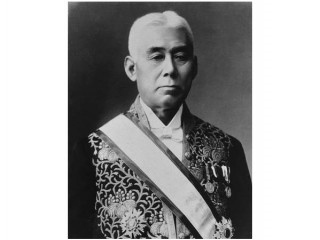
Kei Hara biography
Date of birth : 1856-02-09
Date of death : 1921-11-04
Birthplace : Morioka, Tokugawa shogunate,Japan
Nationality : Japanese
Category : Politics
Last modified : 2011-10-11
Credited as : Prime minister of Japan, High-ranking samurai family, Satsuma-Choshu
The Japanese politician and statesman Kei Hara (1856-1921) was the first commoner and the first professional politician to become prime minister of Japan, initiating the trend toward responsible party government that ended in 1932.
Born to a high-ranking samurai family in the Morioka fief in Iwate province, Hara was given the personal name of Kenjiro, later changed to Satoshi (written with a character read also as Takashi or Kei). The Tokugawa shogunate fell when Hara was 11, and since the Morioka had supported it, Hara's promised future in the feudal system seemed bleak.
Determined to succeed despite this bad luck, Hara made his way to Tokyo in 1872. He first entered a French Catholic seminary, where he was baptized, and later a law school, from which he was expelled for student activism. At 24 he joined the newspaper Hochi but left it when it was taken over by supporters of Toshimichi Okuma, who made it into an antigovernment paper.
Burning with political ambition, Hara decided not to join the opposition or fall in with the dominant Satsuma-Choshu factional leaders but to bore his way up into the oligarchy by making personal connections. Joining the progovernment paper Daito, he ingratiated himself with the oligarch Kaoru Inoue, who got him a post in the Japanese embassy in France and later in the Ministry of Agriculture. There Hara became the protégé of Munemitsu Mutsu, who had once opposed the oligarchy but now was making his way upward into it through his own abilities. Mutsu became foreign minister in 1893. He helped Hara into better positions but resigned for ill health. Hara then left the government, too, becoming president of the Osaka newspaper Mainichi for 3 years.
Learning of Hirobumi Ito's intention of launching a political party (the Seiyukai) in 1900, Hara rushed back to Tokyo and was made the party's chief secretary. Because of
his ability to conduct delicate negotiations, manage the party, and collect political funds, Hara himself became Seiyukai president in 1914. Hara was elevated to the premiership in September 1918 with the reluctant approval of conservative oligarch Aritomo Yamagata, who disliked seeing a "party man, " a member of the Lower House, and a commoner become premier, but he got Hara to promise to push through big defense appropriations.
While the Hara Cabinet was hailed as the first in Japanese parliamentary history to be made up entirely of party members and as initiating the trend toward responsible party government, it was full of ironies. Hara was a "commoner" only because he felt too aristocratic to accept a peerage from the Meiji oligarchs. His moves toward a party spoils system and his countenancing of political corruption not only caused his assassination by a disgruntled railway switchman on Nov. 4, 1921, but contributed to the eventual undermining of confidence in party government.
An interesting treatment of Hara's early political career is Tetsuo Najita's monograph Hara Kei in the Politics of Compromise, 1904-1915 (1967). His later life and the significance of his premiership are discussed in Peter Duus, Party Rivalry and Political Change in Taisho Japan (1968). □
















